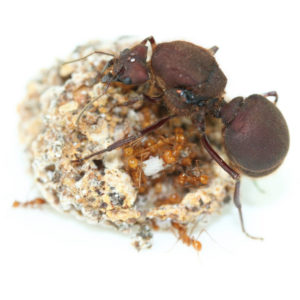Formica fusca – Colony with Queen and Workers
A good-sized, easy-to-feed species, heavy spawning in summer and capable of collective transport! She defends herself with formic acid.
Description
The Ant Farming Charter on our Ants:
1. Establishment approved by the Veterinary Services and the prefecture, in possession of the certificate of capacity for the sale of ants (decision No. 2016195-0002 of the Departmental Directorate for the Protection of Populations), 2
. Perfect Ant Farmer's Guide offered and health sheet provided,
3. Ants guaranteed free of mites and parasites,
4. Health demonstrated by the laying of the queen and the presence of brood on shipment,
5. No “boost” (addition of brood or external workers to sell the colonies faster),
6. Delivery guaranteed in good health: partial refund in case of loss of workers, total in case of loss of the queen (if delivered within 48 hours), 7.
Shipping possible from -12°C to +40°C thanks to our optional isothermal packaging,
8. Species present in France, non-invasive and not threatened,
9. Colony taken back and costs covered if you wish to part with it (see conditions).
______________________________________________________________________________________________
Formica fusca is a species that feeds on insects and sweet liquids, easy to raise, with a very black coloring (more so than Formica cunicularia). It does not hesitate to hunt small prey using formic acid once its population is sufficient. This is a good choice for observing an interesting species. It is often colonized and plundered by Formica sanguinea slave ants, in fact, their queen comes to found her colony near the Formica fusca nest and steals cocoons to raise fusca workers as slaves in her service. She will then end up killing the queen fusca and then organize regular raids against other colonies to obtain free labor...
The humidity requirement of Formica fusca is average and a rather long and cold wintering must be followed after significant feeding (2 to 4 months between 6 and 15°C).
Formica fusca grow rapidly and can have several queens per colony. The brood is often substantial and the nymphs are protected inside a cocoon. We notice the presence of Formica fusca in many sandy as well as mountainous biotopes where they can find aphids for millat and insects to feed.
With a very effective social behavior, Formica fusca are able to move quickly to a new habitat and are able to carry each other! Indeed, when a better habitat is discovered, the first ant carries another towards this new place. The two ants then return to the original nest and carry two each, and return to 4, until the entire colony is settled!
The workers do not hesitate to pull and drag the queen to the new nest.
Good hunters, Formica can secrete formic acid to defend themselves or kill their prey. Sweet and protein liquids, however, will have particular success due to their habit of raising aphids for honeydew.
| Latin name: | Formica (Serviformica) fusca | |
| Common name : | Slave ant (rarely used) | |
| Taxonomy: | Subfamily: Formicinae Genus: Formicini | |
| Breeding difficulty: | (1) Easy to raise but must be protected from stress, and especially in small spaces where the emission of formic acid can poison them themselves. Plan for a long wintering. | |
| Distribution : | All of Europe, especially temperate, as well as part of North Africa. | |
| Natural inhabitant: | In the ground, in dry to humid environments with meadows, plains and mountains. | |
| Polygyny: | polygynous, may have several queens per colony. | |
| Queen: | Size: approx. 12mm Color: shiny black | |
| Workers: | Size: 4 – 8 mm Colour : Shiny black, slightly orange or yellowish legs. | |
| Soldier: | No soldiers. | |
| Males: | Smaller and black. With wings. | |
| Feed : | Sweet liquids and insects, flies, mosquitoes, small crickets and cockroaches, aphid honey. | |
| Humidity : | Hunting area: Ambient humidity. Nest: about 50-75% should be wet, part of which is very wet. Tolerates some drought. | |
| Temperature: | Hunting area: 18 – 28°C Nest : a hot spot at 28°C strongly stimulates the growth of larvae. | |
| Hibernation: | Obligatory, from the end of October until February or March between 5 and 15°C. | |
| Type of natural nest: | In the ground, sometimes in dead wood. | |
| Type of artificial nest: | Plexi/plaster hybrid nest Ant farming, terrarium, digging nest, etc. Avoid all Plexiglas. | |
| Nest size: | Allow 8mm minimum (Minora, Medium etc) and start with a moderate surface to limit soiling. | |
| Substrate: | Sand/clay mixture. | |
| Plants: | Frequents plants colonized by aphids to feed. | |
| Decoration: | Avoid materials susceptible to mold. | |
| Summary : | Serviformica fusca is a rather combative medium-sized species, although it knows how to share its territory with the many species around it (Tetramorium, Lasius etc) . If necessary, they effectively recruit fighters with their fast movements, and can easily access food. It is often the slave of Formica sanguinea , but also of Polyergus rufescens. Very easy to raise. | |
| Life cycle : | Swarming: End of June to August, Foundation: monastic (independent, without feeding the queen) but also sometimes Pleometrose and Adoptions are possible. From egg to adult, about 4-6 weeks depending on temperature. Estimated maximum size: approx. 2,000 workers. |
|
| Quantity on sale: | From a fertilized queen, according to options. | |
| More information : | - Reference |
Further information
| Number of queens | |
|---|---|
| Number of workers | |
| Young colony feeding area | Tube + Plexi feeding area, Tube with ants only |
You must be logged in to post a review.




Notice
There are no reviews yet.